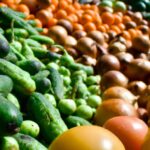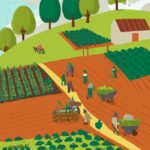Food security is a critical issue globally, affecting millions of people. It refers to having access to sufficient, safe, and nutritious food to meet dietary needs. In many regions, however, food insecurity remains rampant. This can be attributed to various factors such as poverty, conflict, climate change, and limited access to resources. Food security is not just about quantity, but also quality. It entails having access to diverse food options that promote a balanced diet. To address this challenge, governments, organizations, and individuals must collaborate to improve agricultural practices, invest in sustainable farming methods, and promote equitable distribution of resources to ensure food security for all.
Table of Contents
- Causes of food insecurity
- Effects of climate change on food security.
- Global and regional efforts to combat food insecurity
- Impact of food insecurity on society
- Strategies to improve food security
(State of Food Security and Nutrition in the World 2023)
Food security is a growing concern worldwide. It refers to the availability, accessibility, and affordability of nutritious food for all individuals. Lack of food security can lead to malnutrition, hunger, and various health issues.
One of the main factors influencing food security is the global population growth. With more people to feed, the demand for food increases. Additionally, climate change and extreme weather events pose a threat to agriculture, affecting crop yields and food production.
In order to ensure food security, it is important to focus on sustainable agricultural practices. Utilizing modern farming techniques, such as organic farming and precision agriculture, can help maximize crop yields while reducing environmental impact.
Improved storage and transportation systems are also crucial to prevent food waste and ensure that food reaches those in need. Developing countries often lack proper infrastructure for these purposes, leading to significant losses in food supply.
Furthermore, promoting education and awareness about nutrition and food choices is essential. This helps individuals make informed decisions about their diets, leading to healthier, balanced meals.
Efforts to address food security should also involve government policies and international collaborations. This includes investing in research and development for agriculture, implementing social safety nets, and supporting small-scale farmers.
Overall, achieving food security requires a multi-dimensional approach, involving various stakeholders. By prioritizing sustainable agriculture, reducing food waste, promoting education, and implementing effective policies, we can work towards a world where everyone has access to safe, nutritious, and affordable food.
Causes of food insecurity
Food insecurity refers to a lack of consistent access to enough nutritious food for an active and healthy life. The causes of food insecurity are varied and complex. One major cause is poverty, which limits people’s ability to purchase food. In low-income countries, rural poverty is particularly prevalent, with many individuals unable to afford enough food for themselves and their families.
Another contributing factor is conflict and political instability. When countries experience conflicts, resources are diverted away from food production and distribution. The destruction of infrastructure and displacement of populations further exacerbate food insecurity.
Climate change is also a significant cause of food insecurity. Rising temperatures, changing rainfall patterns, and extreme weather events such as droughts and floods, all have detrimental effects on agriculture. Small-scale farmers, who rely heavily on rain-fed agriculture, are especially vulnerable to these climate-related challenges.
Natural disasters, such as earthquakes, hurricanes, and tsunamis, can devastate agricultural lands and infrastructure, leading to food shortages. These disasters often occur in already vulnerable regions, exacerbating existing food insecurity.
Limited access to land and resources is another cause of food insecurity. Land degradation, deforestation, and water scarcity reduce the productivity of agricultural lands, making it difficult for farmers to grow sufficient crops. Unequal distribution of resources and land rights also contribute to food insecurity by limiting opportunities for marginalized communities to grow their own food.
Global economic factors, such as market volatility and fluctuating food prices, also play a role in food insecurity. When food prices rise, people with limited resources struggle to afford nutritious food. Similarly, economic crises, like recessions and inflation, can further exacerbate food insecurity.
Inadequate infrastructure and insufficient investment in agriculture are additional causes of food insecurity. Poor transportation networks, lack of storage facilities, and limited access to markets prevent the efficient distribution of food. Insufficient investment in agricultural research and development also hinders productivity and resilience in the agricultural sector.
Addressing the causes of food insecurity requires a comprehensive and multi-faceted approach. Efforts should focus on poverty alleviation, conflict resolution and prevention, climate change adaptation, disaster preparedness, equitable land and resource distribution, and sustainable economic development. Investment in agriculture, including small-scale farmers and rural infrastructure, is crucial to ensuring long-term food security for all people. By addressing the root causes of food insecurity, we can work towards a more equitable and resilient food system that provides nutritious food for everyone.
Effects of climate change on food security.
Climate change has significant effects on food security, posing a daunting challenge to global food production and availability. The consequences are felt through various channels, including altered weather patterns leading to unpredictable crop yields, heightened occurrence of extreme weather events, and increased pest and disease pressure.
One of the prominent impacts of climate change on food security is the change in rainfall patterns. Regions that traditionally relied on predictable rainfall for agriculture are experiencing unpredictable and erratic rainfall, leading to crop failures and reduced yields. This uncertainty affects farmers’ livelihoods, particularly small-scale farmers who lack resources to adapt to these changing conditions.
Extreme weather events, such as floods and droughts, are becoming more frequent and intense due to climate change. These events can devastate entire crop fields, destroy infrastructure, and disrupt the entire food supply chain. Displaced communities and damaged infrastructure further exacerbate the challenges of ensuring food security, leaving vulnerable populations more susceptible to food shortages and malnutrition.
Rising temperatures also have implications for food production and availability. High temperatures can cause heat stress in crops, leading to reduced yields and quality. Additionally, changing temperatures can disrupt the delicate balance required for the reproduction of pollinators, such as bees, which are vital for crop pollination. This disruption can result in decreased crop productivity and lower food availability.
Climate change also influences the spread and occurrence of pests and diseases that affect crops. Warmer temperatures create favorable conditions for the proliferation of pests, increasing the likelihood of crop damage and reducing yields. Invasive species, such as the fall armyworm, have already caused significant damage to crops in various regions, further threatening food security.
The impacts of climate change on food security are not limited to crop production alone. In marine ecosystems, rising temperatures and ocean acidification disrupt marine food chains, affecting the abundance and availability of fish and seafood. This poses a significant threat to coastal communities that rely on fishing as a primary source of food and income.
It is crucial to address the challenges posed by climate change to ensure food security for present and future generations. Strategies such as promoting climate-smart agriculture, investing in resilient infrastructure, supporting small-scale farmers, and enhancing early warning systems can help mitigate the negative impacts of climate change on food security. International cooperation and concerted efforts are necessary to adapt to these changes and build a more sustainable and secure future for global food systems.
Global and regional efforts to combat food insecurity
Global and regional efforts to combat food insecurity are crucial to addressing one of the most pressing issues facing our world today. With millions of people suffering from hunger and malnutrition, it is imperative that countries come together to find sustainable solutions.
On a global scale, organizations such as the United Nations Food and Agriculture Organization (FAO) play a leading role in coordinating efforts to combat food insecurity. Through initiatives like the Sustainable Development Goals (SDGs), the FAO works with governments, international partners, and local communities to promote agricultural development, improve food production systems, and increase access to nutritious food.
At the regional level, organizations like the African Union (AU) have launched initiatives to address food security challenges specific to their region. The AU’s Comprehensive Africa Agriculture Development Program (CAADP) focuses on increasing agricultural productivity, promoting food trade within the continent, and strengthening resilience to climate change.
One of the key strategies in combating food insecurity is promoting sustainable agricultural practices. This involves prioritizing agroecology, which emphasizes the use of natural resources, biodiversity, and ecological processes to enhance productivity. By employing techniques such as organic farming, crop rotation, and integrated pest management, farmers can improve yields, reduce input costs, and minimize environmental impacts.
Another important aspect of global and regional efforts to combat food insecurity is the promotion of innovative technologies. For example, in sub-Saharan Africa, mobile phone applications are being used to provide farmers with timely weather information, market prices, and farming tips. These technologies enable farmers to make informed decisions, increase their productivity, and access broader markets.
Furthermore, supporting small-scale farmers and empowering women in agriculture are essential components of addressing food insecurity. Small-scale farmers play a crucial role in feeding their communities and often face numerous challenges, including limited access to credit, land, and markets. By providing them with the necessary resources and support, we can enhance their productivity and contribute to improved food security.
In conclusion, global and regional efforts to combat food insecurity are vital in our fight against hunger and malnutrition. By implementing sustainable agricultural practices, embracing innovative technologies, and supporting small-scale farmers, we can make significant progress in ensuring that everyone has access to safe, nutritious, and affordable food. It is only through collective action and collaboration that we can create a world where no one goes to bed hungry.
(Food security – A growing dilemma | DW Documentary)
Impact of food insecurity on society
Food insecurity has a profound impact on society, affecting individuals, families, and entire communities. When people do not have consistent access to nutritious food, the consequences can be far-reaching.
Firstly, the health of individuals is hindered by food insecurity. Without enough nutritious food, people are at a higher risk of developing chronic diseases such as diabetes, heart disease, and obesity. Additionally, malnutrition and undernourishment can impair physical and cognitive development, particularly in children. These health issues not only affect individuals but also strain healthcare systems, increasing the burden on society.
Secondly, food insecurity contributes to economic instability. When individuals struggle to afford food, they often have to prioritize basic necessities, such as rent and utilities, over groceries. This can lead to financial strain, debt, and even homelessness. Moreover, the economic consequences extend to businesses in communities where food insecurity is prevalent, as decreased consumer spending impacts local economies.
Furthermore, food insecurity impacts educational outcomes. Children facing food insecurity often struggle to concentrate in school due to hunger and fatigue. This can result in lower academic achievement, decreased attendance, and increased dropout rates. Consequently, the long-term consequences of inadequate education can perpetuate the cycle of food insecurity, contributing to societal inequality.
Psychological well-being is also affected by food insecurity. The stress of not knowing where the next meal will come from can lead to anxiety, depression, and overall poor mental health. Furthermore, the stigma associated with seeking assistance can compound these emotional burdens, making it difficult for individuals to access available resources and support.
Lastly, food insecurity undermines social cohesion and increases social disparities. When individuals and families are focused on meeting their basic needs, community engagement and participation can suffer. This can weaken social connections, reduce trust, and lead to social isolation. Moreover, marginalized populations, such as racial and ethnic minorities, are often disproportionately affected by food insecurity, exacerbating existing inequalities.
In conclusion, the impact of food insecurity on society is significant and multifaceted. It affects individuals’ health, economic stability, educational outcomes, psychological well-being, and social cohesion. Addressing food insecurity requires a multi-level approach that includes policy changes, increased access to nutritious food, and community support systems. By working together, we can create a society in which everyone has access to adequate and nutritious food, enabling individuals to thrive and communities to prosper.
Strategies to improve food security
Strategies to improve food security are essential for ensuring that all individuals have access to sufficient, safe, and nutritious food. One strategy is promoting sustainable agriculture practices, such as organic farming and agroforestry, to enhance crop productivity while preserving natural resources. These methods reduce reliance on chemical inputs, minimize soil erosion, and promote biodiversity, resulting in long-term food production.
Another strategy involves investing in research and development to develop high-yielding and climate-resilient crop varieties. This includes breeding crops that can withstand drought, floods, or pests, ensuring stable food production even in challenging environments. Additionally, investing in irrigation systems and infrastructure can improve water management, enabling farmers to grow crops throughout the year.
Improving access to credit and financial services is crucial for small-scale farmers. By providing loans or savings options, farmers can invest in quality seeds, fertilizers, and tools, ultimately boosting their productivity and income. Access to markets is equally important. Strengthening transportation networks and creating market linkages can help farmers sell their products at fair prices, reducing post-harvest losses and improving profitability.
Education and training play a vital role in enhancing food security. By educating farmers on modern farming techniques, proper land management, and sustainable practices, they can maximize their yields while minimizing negative environmental impacts. Additionally, providing nutrition education to communities can promote healthier eating habits and reduce food waste.
Social safety nets and policies aimed at reducing inequality also contribute to food security. By implementing programs that provide direct support to vulnerable populations, such as cash transfers or food assistance, governments can ensure that everyone has access to adequate food. These programs can be particularly beneficial during times of crisis or economic shocks.
Finally, promoting regional and international cooperation is crucial. Collaboration between countries can facilitate the sharing of knowledge, technology, and resources, ultimately strengthening food security on a global scale. This can involve joint research projects, trade agreements, and regional networks to address common challenges and promote sustainable development.
In conclusion, improving food security requires a multifaceted approach that addresses issues related to agriculture, education, infrastructure, and socio-economic factors. By implementing strategies such as sustainable farming practices, investing in research and development, ensuring access to credit and markets, promoting education, and fostering cooperation, we can work towards a world where no one goes hungry.













